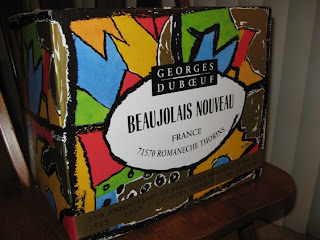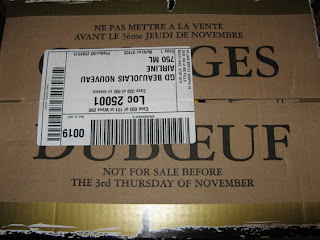
I may have been lax so far in updating this blog, I thought that I would finally post about the turkey we did for
Thanksgiving. We managed to wrangle a free range organic bird weighing 11 pounds from the local health food shop (rather than the local
megamart).
There were six basic steps that I go through to prepare a turkey over two days:
1. Brine the turkey (two days out)
2. Dry the turkey (afternoon before)
3. Prepare the turkey for the oven (morning)
4. Cook the turkey low and slow, then
5. Glaze and brown the turkey high and fast
6. Rest the bird, carve then eat!
So we begin with step 1: the brine.
Brining the turkey does a few things. It makes the bird plump and juicy, as well as seasoning the bird and introducing other flavours into the meat. The basic recipe for the brine is 3/4 cup of salt and 3/4 cup brown sugar to 1 gallon (4 Litres) of water. I ended up doubling this recipe for the turkey in order to fit it fully submerged in the bringing container.
To this you can add any number of flavours that will complement the final flavour profile you want. For this turkey, I went with bay leaves (3), black pepper corns (1 tbsp), cinnamon sticks (2) and juniper berries (1 tbsp). Simply place the sugar, salt and seasonings in a saucepan and add about 2 cups of the water. Bring to a simmer then simmer for about 10
mins. Allow to cool thoroughly then refrigerate along with the rest of the water you will use. Once cool, add the mix to the container then place in the bird, washed, which should be fully submerged in the brine. Leave it in a cool place for at least 8 hours or preferably overnight.
The turkey ready to be washed.

The turkey in the brine. Yes I used a cooler (an
esky for those in OZ) as the container, as it keeps the bird cool. You can also add ice to the mix to keep the temperature down.

Step 2: Dry the bird. In order to get a nice skin formed, it's important that the bird is dried thoroughly. To do this, I remove the bird from the brine, rinse well then dry with kitchen paper (or an old kitchen towel). Place on the rack you will eventually cook it in, place it over a tray and stash in the refrigerator overnight.
Step 3: Prepare the turkey for the oven. The first step to this is to remove the bird from the refrigerator at least an hour before cooking to allow it to come to room temperature. As the first cooking is done at a low temperature, this step will greatly reduce the overall cooking time.
To prepare the turkey, we have to consider two things, the cavity and the roasting tray under the bird. Firstly, I never stuff the turkey with stuffing. The basic idea is that by the time the middle of the stuffing has reached the safe temperature for killing bacteria, the meat itself, especially the breasts will be overcooked and dry. However I do stuff the cavity with lots of aromatics. In this case, I used 1 lemon, 1 orange, 1/2 onion and a bunch of sage. Simply quarter everything and stuff it in the cavity. There is no need to season the cavity however as the brine has done that job for you.
In the roasting pan underneath the turkey, I place lots of vegetables to get a head start on the gravy. I used 3 carrots, 2 onions, 6 stalks
celery and 2 heads garlic (yes whole heads). Simply chop roughly, and slice the heads of garlic in half. Place these in the bottom of the roasting tray before putting the turkey in it's rack on top. If you don't
have a rack, just build a small mound from the vegetables and put the turkey straight on that. Finally give the skin of the turkey a good rub down with oil and it's ready for the oven.
Rubbing down the prepared turkey.

Step 4: Cook the turkey low and slow. One of the secrets to cooking such a large piece of meat is to actually cook it low and slow to start. This will bring the inside temperature of the meat up without overcooking the outside. So preheat the oven to 250F (120C) for about half an hour before placing the bird in the oven.
If you have a thermometer designed to go in the oven (the best way of ensuring a well cooked turkey) place it in the bird now. On the day I was about to use my probe thermometer, which consists of a thermocouple probe that stays in the turkey, connected to a temperature gauge outside the oven. Unfortunately the probe wire somehow burned out on the morning after about half an hour in the oven, so we quickly changed
tac, went low tech, and stuck Robin's roasting thermometer in instead (the one you can see in the top pick). A final note, once you stick the thermometer in, it stays there until carving. Otherwise you end up with a gaping wound for any juice to pour out. That goes for the
annoying little pop timer that most turkeys come with; leave it in but rely on your thermometer.
Once the bird is in the oven, you want to cook the bird until it registers an internal temperature of 155F (68C). While the safe temperature for turkey is 165F (74C), the turkey will continue cooking from both the hot blast once the glaze is on, as well as carryover. For those of you who don't know, carryover is the process where by the meat continues to cook even though you have removed it from the oven. Basically if it's done once it's removed, then it's overdone by the time it's rested. If you look closely at the picture at the top of the post, the final temperature of my glazed bird was just below 160F.
Step 5. Glaze and brown the turkey high and fast. Once the turkey has reached an internal temperature of 155F, remove the bird and raise the temperature of the oven to 450F (230C). Glaze the turkey with the prepared glaze then once the oven has reached the required temperature, place the bird back in for 5
mins. Remove, glaze again and cook for a further 5
mins. Finally remove the bird, give it a final glaze.
While you can use what ever you like in your glaze to match the flavour profile you are shooting for, I went with an orange, ginger and sage glaze. Simply reduce 1 1/2 cups orange juice with 2 tbsp brown sugar, 1 tbsp grated ginger and a few
shredded sage leaves until syrupy.
6. Rest the bird, carve then eat! Resting is without a doubt one of the most important steps in roasting any meat, especially large pieces like turkey. A good rule of thumb is for a turkey this large to rest for about half an hour, any bigger and I would even go up to 45
mins. Once the final glaze has been applied, wrap the turkey well in aluminium foil and leave to rest UPSIDE DOWN. That's right, a little trick I picked up from Maggie Beer. Doing this will allow any juices to naturally make their way to the (usually dryer) breast meat, making it
juicier.
The bird out of the oven and glazed.

Once rested, its then carved. My technique involves removing the whole breasts then slicing them separately. Remove the legs and thighs as one piece, then chop the leg off and if you want to be really fancy, bone the thigh and slice. In this way you guests will be able to get a bit of the white meat and a bit of the (more tastier) dark meat.

Finally, the gravy. While not essential for everyone, there is so much flavour going to waste in the bottom of the roasting tray it would be a shame not to turn it into a nice gravy. Once the bird is resting, place the roasting tray over heat (I was in Robin's kitchen so I had gas which was great). Add a little turkey stock to the tray and start scraping all the burnt looking bits from the pan with a wooden spoon (the French call those bits in the bottom of a roasting pan the fond, which is the foundation to all good meat sauces). Once most of the bits are dissolved into the stock, add some more stock (about 1 1/2 cups in all) and bring to a simmer, squishing the vegetables in the bottom of the pan to extract as much flavour as you can.
Once the mix has simmered for about 5
mins, strain through a strainer, again pressing on all the vegetables to extract as much liquid as possible. Allow the liquid to settle to see how much fat comes to the surface. Pour this fat off into a saucepan and add enough butter for there to be about 2 tbsp of fat in all. Add 2 tbsp flour and cook for a few minutes. Add the liquid, a little at a time at first,
stirring all the while, until all is added. Simmer this until thickened. This is your basic gravy (or more correctly a
veloute) which you can either serve as is (once you have tasted for seasoning) or jazz it up. In my case, I added a tablespoon of pomegranate glaze, a tablespoon of cream and a tablespoon of butter to give it a further richness. Finally, taste for seasoning to see if it needs more salt. Serve with the sliced turkey and enjoy!

















